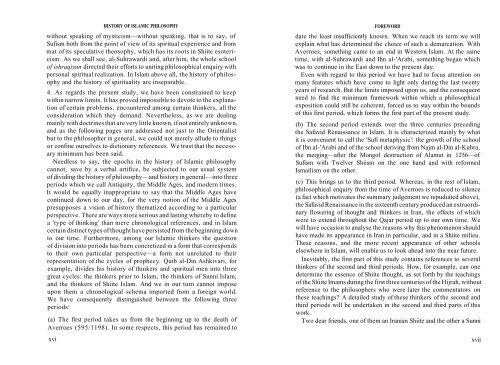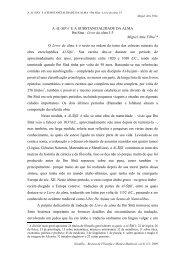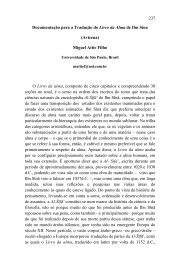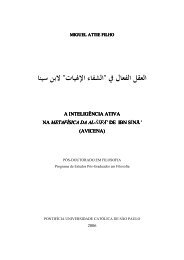History Of Islamic Philosophy - Henry Corbin.pdf - Falsafa
History Of Islamic Philosophy - Henry Corbin.pdf - Falsafa
History Of Islamic Philosophy - Henry Corbin.pdf - Falsafa
Create successful ePaper yourself
Turn your PDF publications into a flip-book with our unique Google optimized e-Paper software.
HISTORY OF ISLAMIC PHILOSOPHY<br />
without speaking of mysticism—without speaking, that is to say, of<br />
Sufism both from the point of view of its spiritual experience and from<br />
mat of its speculative theosophy, which has its roots in Shiite esotericism.<br />
As we shall see, al-Suhrawardi and, after him, the whole school<br />
of ishraqiyun directed their efforts to uniting philosophical enquiry with<br />
personal spiritual realization. In Islam above all, the history of philosophy<br />
and the history of spirituality are inseparable.<br />
4. As regards the present study, we have been constrained to keep<br />
within narrow limits. It has proved impossible to devote to the explanation<br />
of certain problems, encountered among certain thinkers, all the<br />
consideration which they demand. Nevertheless, as we are dealing<br />
mainly with doctrines that are very little known, if not entirely unknown,<br />
and as the following pages are addressed not just to the Orientalist<br />
but to the philosopher in general, we could not merely allude to things<br />
or confine ourselves to dictionary references. We trust that the necessary<br />
minimum has been said.<br />
Needless to say, the epochs in the history of <strong>Islamic</strong> philosophy<br />
cannot, save by a verbal artifice, be subjected to our usual system<br />
of dividing the history of philosophy—and history in general—into three<br />
periods which we call Antiquity, the Middle Ages, and modern times.<br />
It would be equally inappropriate to say that the Middle Ages have<br />
continued down to our day, for the very notion of the Middle Ages<br />
presupposes a vision of history thematized according to a particular<br />
perspective. There are ways more serious and lasting whereby to define<br />
a 'type of thinking' than mere chronological references, and in Islam<br />
certain distinct types of thought have persisted from the beginning down<br />
to our time. Furthermore, among our <strong>Islamic</strong> thinkers the question<br />
of division into periods has been concretized in a form that corresponds<br />
to their own particular perspective—a form not unrelated to their<br />
representation of the cycles of prophecy. Qutb al-Din Ashkivari, for<br />
example, divides his history of thinkers and spiritual men into three<br />
great cycles: the thinkers prior to Islam, the thinkers of Sunni Islam,<br />
and the thinkers of Shiite Islam. And we in our turn cannot impose<br />
upon them a chronological schema imported from a foreign world.<br />
We have consequently distinguished between the following three<br />
periods:<br />
(a) The first period takes us from the beginning up to the death of<br />
Averroes (595/1198). In some respects, this period has remained to<br />
xvi<br />
FOREWORD<br />
date the least insufficiently known. When we reach its term we will<br />
explain what has determined the choice of such a demarcation. With<br />
Averroes, something came to an end in Western Islam. At the same<br />
time, with al-Suhrawardi and Ibn al-'Arabi, something began which<br />
was to continue in the East down to the present day.<br />
Even with regard to this period we have had to focus attention on<br />
many features which have come to light only during the last twenty<br />
years of research. But the limits imposed upon us, and the consequent<br />
need to find the minimum framework within which a philosophical<br />
exposition could still be coherent, forced us to stay within the bounds<br />
of this first period, which forms the first part of the present study.<br />
(b) The second period extends over the three centuries preceding<br />
the Safavid Renaissance in Islam. It is characterized mainly by what<br />
it is convenient to call the 'Sufi metaphysic': the growth of the school<br />
of Ibn al-'Arabi and of the school deriving from Najm al-Din al-Kubra,<br />
the merging—after the Mongol destruction of Alamut in 1256—of<br />
Sufism with Twelver Shiism on the one hand and with reformed<br />
Ismailism on the other.<br />
(c) This brings us to the third period. Whereas, in the rest of Islam,<br />
philosophical enquiry from the time of Averroes is reduced to silence<br />
(a fact which motivates the summary judgement we repudiated above),<br />
the Safavid Renaissance in the sixteenth century produced an extraordinary<br />
flowering of thought and thinkers in Iran, the effects of which<br />
were to extend throughout the Qajar period up to our own time. We<br />
will have occasion to analyse the reasons why this phenomenon should<br />
have made its appearance in Iran in particular, and in a Shiite milieu.<br />
These reasons, and the more recent appearance of other schools<br />
elsewhere in Islam, will enable us to look ahead into the near future.<br />
Inevitably, the first part of this study contains references to several<br />
thinkers of the second and third periods. How, for example, can one<br />
determine the essence of Shiite thought, as set forth by the teachings<br />
of the Shiite Imams during the first three centuries of the Hijrah, without<br />
reference to the philosophers who were later the commentators on<br />
these teachings? A detailed study of these thinkers of the second and<br />
third periods will be undertaken in the second and third parts of this<br />
work.<br />
Two dear friends, one of them an Iranian Shiite and the other a Sunni<br />
xvii







